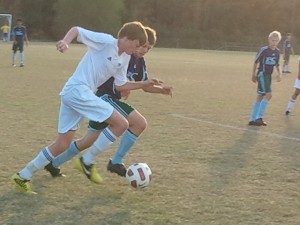Injury Prevention: Not magic, just maintenance
 If your car needs scheduled maintenance, shouldn’t your kid?
If your car needs scheduled maintenance, shouldn’t your kid?
Let’s see. You’re supposed to change your oil every 5,000 miles, rotate the tires every 10,000 and bring her in for the major service check-ups at 15, 30 and 45,000 miles. That’s so your mechanic can inspect, adjust and change things before you break down on the highway.
So, how many miles you got on your kid? Have you oiled up the gears, knocked off the rust and checked the engine? What else needs tuning up for the new season? It’s the perfect time to think about preventive maintenance for your kid; injury prevention, that is.
+READ: LeBolt: How to build a successful travel team without ever cutting a player
Wait. Injuries in kids? They’re practically brand new! Young, agile, fast and excited to learn the sport.
“If an injury happens, we’ll deal with it,” most parents say, and I can’t blame them. No one wants to think about their kid getting hurt. And kids aren’t cars: they don’t come with maintenance schedules. But what if they did?
If we had a preventive maintenance schedule for our kids, wouldn’t we follow it?
It may surprise you to find out that sporting kids, like automobiles, actually do tend to break down in predictable ways. That’s where we can learn from the auto-makers. Based on age, mileage and wear and tear, your kid, just like your car, needs healthy maintenance. Prevention is a lot cheaper than repair, less painful, and a whole lot more fun. That maintenance not only extends the life of the ‘vehicle,’ but helps it run smoother, perform better, and more reliably.
The bodies of athletes are not all that different from automobiles, metaphorically speaking. So shouldn’t there be a preventive maintenance schedule for kids? They don’t come with one, but if you’ve worked with them for a decade or two, you see there is a pattern to the injuries they are most likely to suffer. These are a product of how kids grow, where they are growing fastest, and the wear and tear they put on their joints by virtue of the sport they play. (Soccer players have more injuries to the lower body, baseball players and swimmers to shoulders, football players to… Well, you get the idea.)
Here’s a listing by age of the injuries I see most commonly in soccer:
- Under 6 – skinned knees and hurt feelings
- 9-12 years – foot, heel and Achilles pain
- 12 years and up – ankles
- 15-25 years – knees (ACL, particularly in girls)
- 15+ years – hamstrings and quads (particularly in boys)
- 12-18 years – concussions (not limited to this age, but particularly damaging as brains are growing so quickly now)
 Has your child sustained an “age-predictable” injury? Just because it is common doesn’t mean it’s necessary or inevitable. Areas of growth are always the most fragile, and in a physically demanding environment, those are the weakest links. A healthy preventive maintenance schedule recognizes those tendencies and provides a way to minimize the extent of the injury, decrease its severity and/or prevent it from occurring altogether.
Has your child sustained an “age-predictable” injury? Just because it is common doesn’t mean it’s necessary or inevitable. Areas of growth are always the most fragile, and in a physically demanding environment, those are the weakest links. A healthy preventive maintenance schedule recognizes those tendencies and provides a way to minimize the extent of the injury, decrease its severity and/or prevent it from occurring altogether.
Here’s a primer for preventive maintenance of the most common soccer injuries, by age of the athlete:
- Under 6 – skinned knees and hurt feelings (A hug and a popsicle usually work)
- 9-13 years – foot, heel and Achilles pain (Add insole cushioning for cleat, especially heel, perform regular calf stretching in proper alignment and strengthen when pain-free)
- 12 years and up – ankles (One-legged ankle strengthening watching for imbalances R to L, also static balance and hopping exercises)
- 15-25 years – knees (ACL, particularly in girls) (Knee injury prevention warm up, reinforced with plyometric strengthening and movement that translates into field play)
- 15+ years – hamstring and quad (particularly in boys) (dynamic stretching, dynamic strengthening at performance pace and demand)
- 12-18 years – concussions (not limited to this age, but particularly damaging now as brains are growing so quickly) (Whether or not you choose to teach them heading techniques, upper back, shoulder and core strengthening are essential for defensive positioning in competitive play.)
Chapter 7 of the new Fit2Finish book addresses these youth sports injuries in detail and examines the causes of injuries common to soccer players. In Appendix F, I list symptoms of each injury along with specific training design for pre-habilitation and prevention. (Find the book and more on injury prevention and the application of preventive maintenance for the field at Fit2Finish.)
 Please keep in mind: all injury risk is increased by the volume of training, number of repetitions and the frequency of competition. This is why overuse injuries are on the rise. Spending less, but more focused, time in training will likely pay more dividends with fewer injuries. Plus, there will be time to go out for ice cream or get home for dinner.
Please keep in mind: all injury risk is increased by the volume of training, number of repetitions and the frequency of competition. This is why overuse injuries are on the rise. Spending less, but more focused, time in training will likely pay more dividends with fewer injuries. Plus, there will be time to go out for ice cream or get home for dinner.
We could wait for the alignment to go or the check-engine light to come on before taking it to the body shop for an estimate, but regular preventive maintenance will take us a lot further down the road and make for a lot less stressful trip and an even better family vacation.
SOCCERWIRE MARKETPLACE
- visitRaleigh.com Showcase Series 2025, hosted by NCFC Youth
- OFFICIAL MANCHESTER CITY SOCCER CAMPS
- Wanted Licensed Youth Soccer Coach
- Join Official Elite Summer Soccer Camps with Europe’s Top Pro Clubs!
- The St. James FC Travel Staff Coach - North (Loudoun) & South (Fairfax)
- The St. James FC Girls Academy (GA) Head Coach - 2 teams
- The St James FC Boys Travel Tryouts
- OFFICIAL BAYERN MUNICH SUMMER CAMPS U.S.
- JOIN THE ALLIANCE!
- OFFICIAL FC BARCELONA CAMPS U.S.











